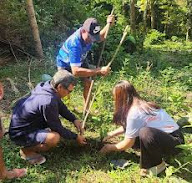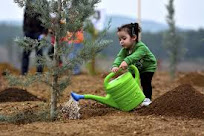Save Millions of Trees this Palm Sunday
Tree Holiday with Coronavirus Pandemic
Let's join the movement Ecological Reconciliation espoused by the Holy Father (Laudato Si' Encyclical), and local church leaders led by Fr Benigno Beltran SVD. This is a yearly appeal from this website addressed to the leaders of the Church, the faithful, and humanity. Let's plant trees instead and take good care of them.
The Christian world loses millions and millions worth of palm trees every Palm Sunday. Coconut-based economy is the worst hit - the source of many domestic and export products, and the foundation of people's livelihood. The coconut is the most important tree in maintaining the balance of tropical ecosystems.
Bundles of palm fronds (young leaves of coconut and other palm trees) attest to the massive destruction and decimation of palms in the Christian world.
Whatever happened to the sacredness of Palm Sunday!
Lavish and wasteful observance of Lent while Nature suffers and people lose their livelihood. Let's join hands to save the trees
- Don't use young (bud) leaves of coconut for palaspas. You will kill the tree.
- Conserve the Oliva or the Cycads. They are living fossils, older than the dinosaurs. They are now endangered.

Oliva or Cycad, a living fossil is now endangered.
- Don't strip the young leaves of buri and anahaw palms. They are now in the list of threatened species.
- Get only the mature leaves - never the young leaves or bud. Get only a small leaf or part of it. Don't be wasteful.
- There's no need for each faithful to carry palaspas. One for a whole family is enough.
- Get substitute plants that are not ecologically endangered and economically threatened. (Examples: MacArthur's Palm, palmera, Areca or betel nut, bunga de Jolo, and 101 non-palm plants from bamboo to ground orchid). Use mature or older leaves - never the young leaves and buds.
- Seek advice from your community and religious leaders, and environmentalists.
Religious Practices Effects to Health and Environment
 • Retreat and reflection is therapy, helps the mind and body release tension and do away with the effects of stress.
• Retreat and reflection is therapy, helps the mind and body release tension and do away with the effects of stress.- Buri palm (Corypha) is now classified as threatened species
• To some religions pork is banned. Pork is a carrier of known parasites such as tapeworm, hookworm, and ascaris.
• On Palm Sunday trees are stripped off of their buds, leaves and stems. This is detrimental to the environment especially in summer when plants face tight water regime. Millions of pesos worth of coconut trees, potential to provide nuts continuously for a period of up to 30 years, are simply sacrificed for a day's ritual. Endangered species such as the Cycad (Oliva), are pushed to the brink of extinction.
• Ancient religions regard certain places and trees sacred, thus enhancing their conservation. Such worship was replaced by later religions, thus losing their protection.
• The washing of feet is not only ritual, it is also sanitation, getting rid of germs and preventing their spread.
. Avoid dipping your fingers into the holy water bowl, and never wash your hands or face in it. Running holy water is best.
. Take communion on your palm, never with your tongue. Epidemic such as H1N1 (flu) can be spread this way.
Holding hands in prayer is discouraged also for health and sanitation, keeping ones privacy in reverence, notwithstanding. Kissing icons is likewise discouraged for the same reason. Wiping holy objects with handkerchief will only pick up germs.
. Paying last respect to the dead should be done with extreme care, especially if the cause of death is highly contagious like anthrax, Ebola and SARS. Remember the tragic death of some religious sisters who contacted Ebola from their dead colleague?
. Don't walk on your knees to the altar; kneeling in prayer is enough. Be kind to your knee tendon and kneecap; knee injury may incapacitate you permanently. "You re not growing younger," an elder advised me. Let's learn from athletes who retired early because of knee injury.
. Removing shoes before entering a house of worship is an expression of respect and reverence, as well as for purposes of maintaining sanitation in the place. Any footwear carries dirt and germs, and may be teems with bacteria and fungi from long and intimate wear. This practice may not be as strict in Catholic churches as in Muslim mosques and Buddhist temples. Removing shoes in other places like prayer rooms, wakes, even homes, are becoming a popular practice.
. Many religious ceremonies are without the use of incense. Incense smoke and scent usually produce a pleasant and calming effect to the faithful. It is also an effective fumigant against flying and crawling insects. Its repellant effect helped keep down the spread of bubonic plague during the Middle Ages. The causal organism which killed a third of the population in the known world is carried by flea (Xenopsylla cheopis) that resides in rats. Incense comes in various preparations and offerings, candle sticks among the most common. Burning candles have similar but lesser effects. To get rid of flies around food, plant one or two burning candles to keep them at bay. Try it.

Sprinkling holy water with lotus flower before entering the Buddha Shrine. (Grand Palace, Bangkok)

Candle offering is often wasteful and dangerous. It also makes the place untidy. A lighted candle in an enclosed room reduces oxygen level while filling it with CO2 and the deadly Carbon Monoxide. (Our Lady of Manaoag Shrine, Manaoag Pangasinan.)
Proof of destruction on the altar of faith could be as evident as after a typhoon and other force majeure on the economy and environment.
Coconut tops other coastal trees against the onslaught of tsunami and storm surge.
(Acknowledgement: Internet and FAO photos)
NOTE: This article served as a yearly lesson for 30 years on the defunct Paaralang Bayan sa Himpapawid with Ms Melly C Tenorio as host and the author as broadcast instructor. 738 DZRB AM, 8 to 9 evening class, Monday to Friday, linked with Philippine Broadcasting Service (PBS) network, and this Blog avrotor.blogspot.com
There are many religious rituals and practices in various faiths that fall under either of the categories – to help or destroy our health and environment. This is a good assignment in schools and community workshops. It is time to review them in the light of health warnings and the environmental concerns, particularly in these critical times.
1. On Palm Sunday trees are stripped of their buds, leaves and stems. This is detrimental to the environment especially in summer when plants face tight water regime.
2. Fasting is cleansing, it helps the body stop the accumulation of unwanted substances such as cholesterol, and allows the body to eliminate toxic materials.
3. Retreat and reflection is therapy, helps the mind and body release tension and do away with the effects of stress.
4. Abstinence conserves animal population especially during the lean months, conserving breeding stocks - like seeds (binhi) – in order to multiply in the next season.
5. To some religions pork is banned. Pork is a carrier of known parasites such as tapeworm, hookworm, and Ascaris.
6. Ancient religions regard certain places and trees sacred, thus enhancing their conservation. Such worship was replaced by later religions, thus losing their protection.
7. The washing of feet is not only ritual, it is also sanitation, getting rid of germs and preventing them to spread.
8. Walking on knees, a form of penitence, usually along the aisle to reach the altar, is harmful to the knee joint and cap (patella).
 9. Self inflicting of wounds imitating the scourging at the pillar, practiced by flagellants may lead to loss of blood, serious infection, and even death.
9. Self inflicting of wounds imitating the scourging at the pillar, practiced by flagellants may lead to loss of blood, serious infection, and even death.10. Communal holy water may become a breeding place of vermin and germs causing ailments and epidemic diseases.
11. Receive holy communion with the palm of your hand to lessen the possibility of disease transmission. (Photos from Internet)
12. Kissing or touching the dead. Diseases like COVID-19, Ebola, SARS, MERS-CoV must be strictly quarantined.~
How do you classify the following practices?
- Removing shoes and slippers before entering a temple of worship
- Viewing the bright sky and even the sun - to witness a miracle
- Wearing robes and habits of holy persons
- Wearing veil when attending mass or any ritual inside the church
- Baptism by immersion in a pool or river
- Offering flowers at the altar, especially in the month of May
- Walking barefoot as penitence, usually under the sun on rough road..
- Actual crucifixion on Good Friday as "ultimate penitence"
- Joining a huge religious assembly or procession such as the Black Nazarene.
- Kissing icons for intercession or expression of reverence. ~
Tree Planting Builds a Strong Ecological Foundation in Children
Acknowledgement: Internet photos



























No comments:
Post a Comment